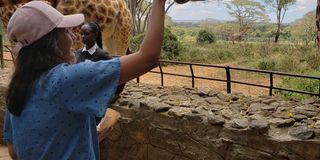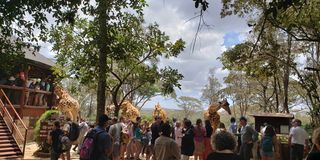Giraffe on the verge of extinction

You might be sad, disappointed or angry after reading this article, but that’s exactly my intention. Perhaps you’ll be able to channel it into a bigger conversation that needs to start now.
Will the future generation be able to see a giraffe in the wild? This thought never crossed my mind at first when I spotted a lonely giraffe during my recent trip to untouched wilderness of Shimba Hills National Reserve in the coast of Kenya. Being the only tourist car in the reserve that day and staring at the ‘only’ giraffe the reserve has, I could only think of ‘cool’ puns – only to come to learn from my ranger cum guide, Halfan Khamis, the majestic creature is facing extinction. “You are media, you knew right?” Halfan says. His question never left my thoughts.

On the contrary, in the other part of Kenya, hundreds of tourists like I flock to the Giraffe Centre in Nairobi to feed the tallest animal in the world. ‘Will my 20-month-old daughter get to see a giraffe when she’s my age?’ I ponder over this question as I feed Edd, one of the friendliest of the few endangered Rothschild giraffes being bred and taken care of at the centre.
Edd’s very long, dark blue-blackish tongue sticks out and reaches out to slurp up pellets of food from my hand, leaving my hand buttered with its saliva. The main purpose of the centre is to educate school children and youth on their country’s wildlife and environment, as well as give local and international visitors an opportunity to come into close contact with the world’s tallest species, the giraffe – like myself, so I learn from my guide. The International Union for Conservation of Nature (IUCN) listed giraffes as critically endangered and said their population had fallen by up to 40 per cent over the last three decades.

How bad is the problem?
Edd and his family of 9 have a blessed life – they are taken care of with attention by the keepers, are in a safe place and are spoilt for choice when it comes to food – as thousands of people from all over the country and world come to feed them.
But not all the giraffes in East Africa are as lucky as Edd and his family. Numbers have gone from around 155,000 in 1985 to 97,000 in 2015 according to IUCN – the decline attributed to habitat loss, poaching and civil unrest in many parts of Africa. According to Dr Julian Fennessy, who co-chairs the IUCN giraffe specialist group, the creatures are undergoing a “silent extinction”.
I go back pondering on Halfan’s question – if we are media, how come our national symbol isn’t making headlines to start a ‘big’ conversation to educate the communities within the region on conservation and awareness? While there have been great concerns about the rhino, giraffes have gone under radar, unfortunately, their numbers falling. Presently, there are nine species of Giraffes across Africa. In Tanzania, there are four that includes the Masai giraffe – one of the most endangered subspecies of giraffes.
An estimated 35,000 Masai giraffes remains, a subspecies spread throughout Kenya and Tanzania that are endangered, primarily because of poaching and changes in land use, national geographic (NatGeo) report. There are remaining, but their population has fallen by nearly 50 per cent in the last three decades.
Hunting giraffes is illegal in East Africa but NatGeo reports that they are poached for their hide, meat, bones, and tails. An estimated 2 to 10 per cent of the population is hunted illegally every year in Serengeti National Park in Tanzania, according to the IUCN. Just few months ago, Kenya Wildlife Service uncovered 800kg of bush meat that was being illegally traded at the popular Burma Market in Nairobi’s Eastlands.
Poaching has increased because of civil unrest and emerging markets for giraffe parts, including tail-hair jewellery and bone carvings. There’s even a belief among some that giraffe bone marrow and brains can cure HIV and AIDS, Tanzanian media have reported.
Tracking and solution
Falling number of giraffes, a national symbol of the country, has alarmed wildlife experts in the country and demand a census dedicated to the animal. In an article by The Citizen last year, it was reported that the decline in the number of giraffes in the country was more pronounced in Moyowosi-Kigosi ecosystem in western parts of the country where the number has dropped to 1000 from over 5000 in the last few years.
Dr George Lohay, a biologist doing research on wildlife conservation and working with the Wild Nature Institute’s giraffe conservation project in Tanzania said it’s sad to see the numbers of this iconic animal fall.
One of the major reasons for their decline in Tanzania is poaching, mainly for trophy and meat, Dr Lohay tells. The other major threat, Dr Lohay explains is habitat loss and habitat fragmentation, a consequence of human development, activities or disappearance of natural environment that is resulting in the decline of the number of sub-species of giraffes.
“The third is what we have found but it has not been researched enough is a certain kind of skin disease on giraffes that usually starts around the knees area. This does affect the populous but it still needs to be researched to what extent it impacts them,” Dr Lohay tells.
Though anti-poaching efforts are commendable in Tanzania’s various national parks and reserves, there’s a hidden threat or rather the forgotten side of poaching that Dr Lohay deems ‘big’ - wire snare, a trapping device, usually consisting of a noose (made from wire). “Giraffes and other animals in the wild are being injured and killed by communities living around these parks for various reasons such as bush meat trade. I remember removing 10 snares from a certain area in the park in one day, the number can even reach 1000 for a certain area. This is a big problem and authorities need to urgently address and approach on how to curb it,” he says.
Juma the Giraffe
One of the many efforts Dr Lohay and his team are doing is reaching out to primary school students in delivering giraffe-themed environmental education to emphasise how important giraffes are in our ecosystem and why we need to conserve them with the aim of changing attitudes towards the majestic creature.
Juma the Giraffe, a children’s book teaches ecological and social lessons, build national pride in Tanzanian wildlife, and motivate children to learn about their natural world. Juma the Giraffe is a heart-warming story about how every individual is unique and special, both on the outside and on the inside. “We are reaching primary and secondary school children aged 4 to 16 throughout Tanzania. We are distributing Juma the Giraffe and an activity book to each primary school child. But I do hope that this kind of lesson can reach every primary school in Tanzania, and not just the schools neighbouring the protected areas,” Dr Lohay tells.

Beyond a photo
As I continued to admire the iconic animal at the Giraffe centre in Nairobi, an educator asks me, “Ma’am. Would you like to kiss him?” I was in awe. “Don’t worry, its saliva has antiseptic properties,” he informs.
The educator asked me to put the food pellet pursed between my lips. I did so and got ready for my perfect Instagram-worthy photo. Edd came closer and reached out to the food pellet, slathering my mouth with its sticky saliva. Though it wasn’t romantic, Edd and I were captured in a perfect frame. As I look at the photo today, I hope the future generation get to see and experience the same – and do not admire the world’s tallest animal just as beautiful figures in a story book, like Juma the Giraffe, or remain history as the once upon a time tallest, majestic animal of our national emblem.




